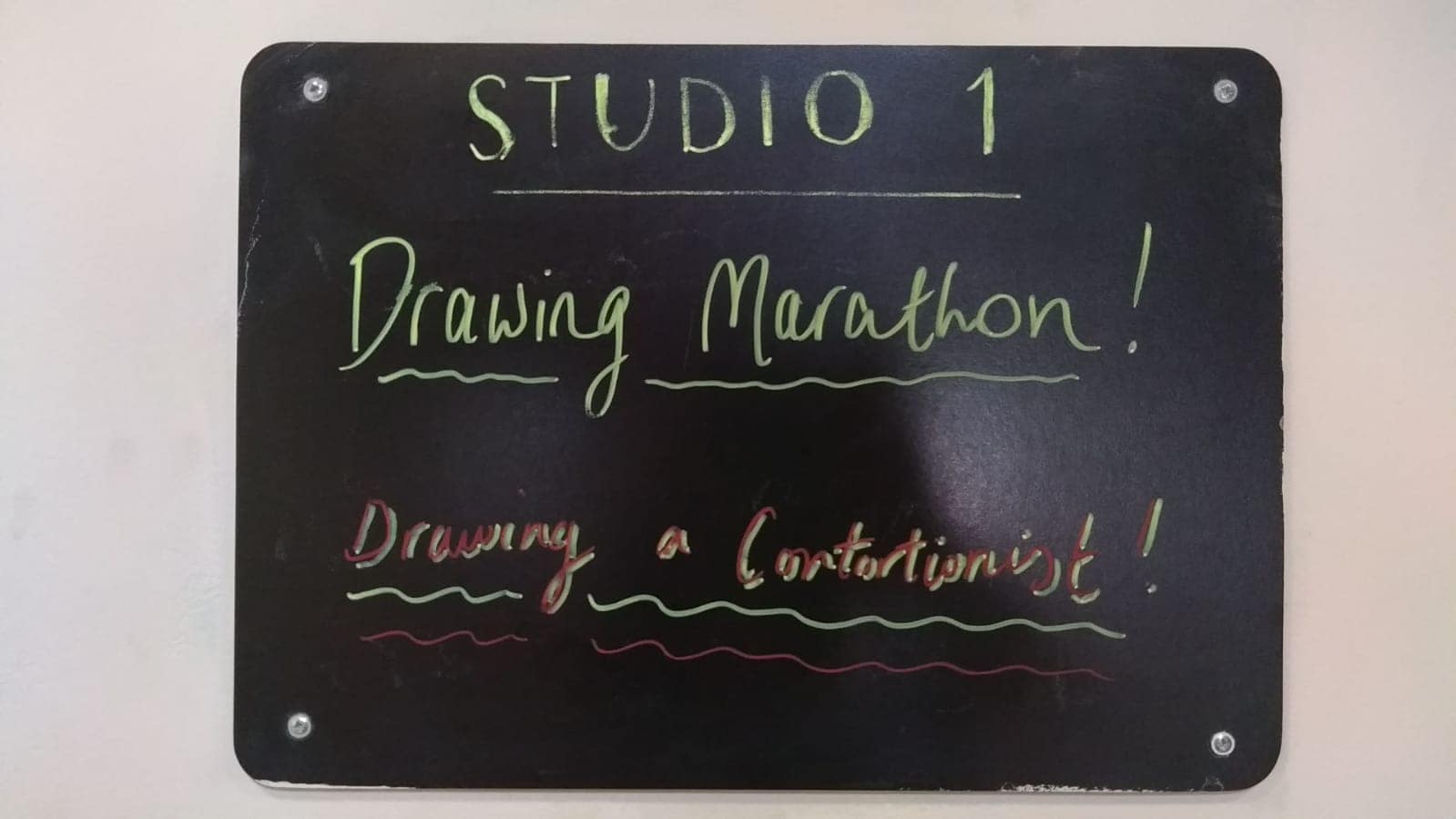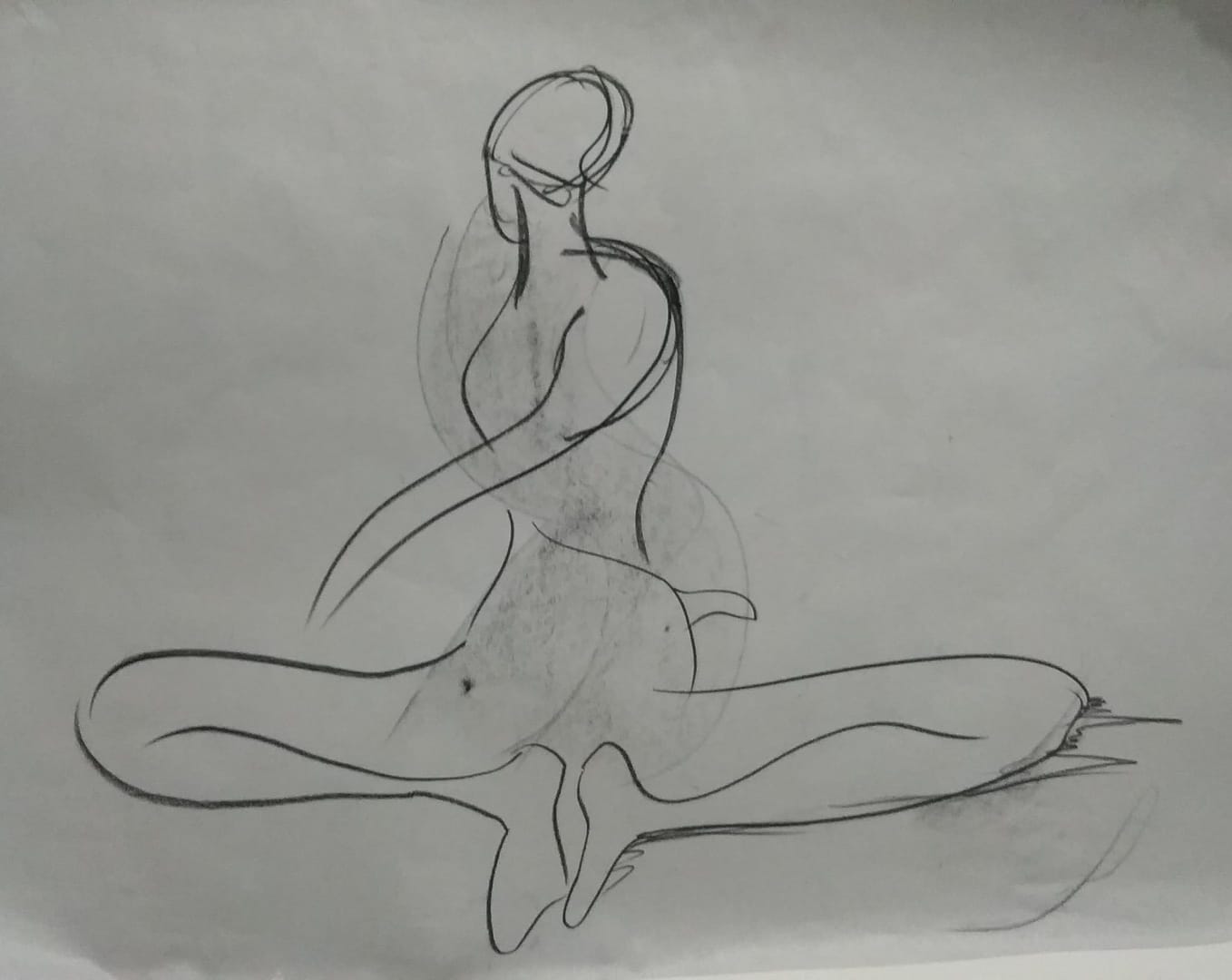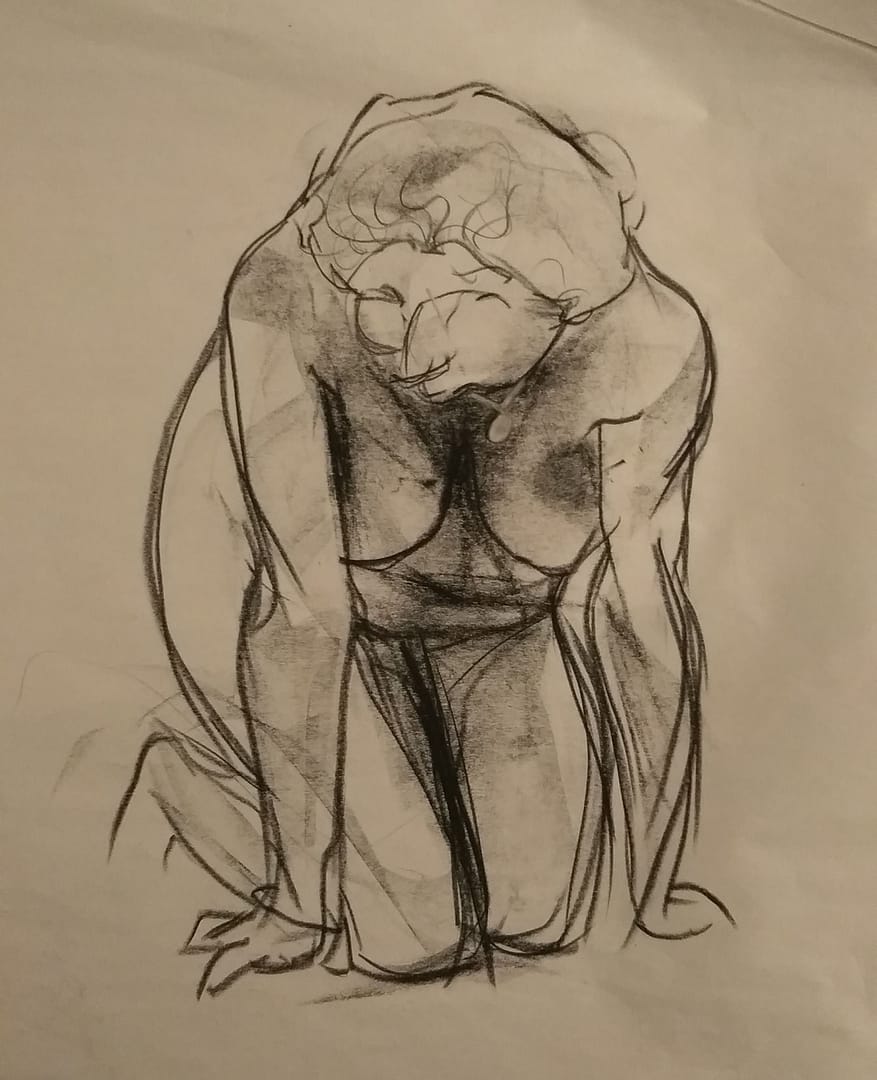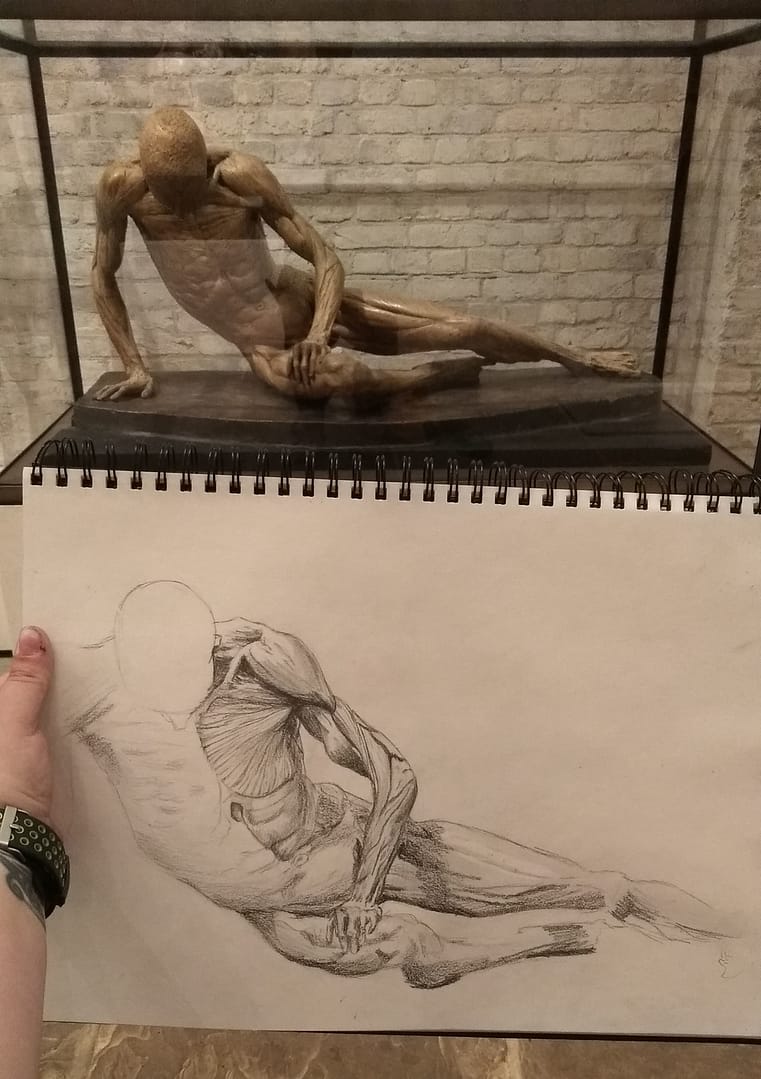Last month, I went to the Royal Drawing School in London to take part in their 2 week Drawing Marathon. This experience was the core part of my Emergence Bursary from artist-network, Shape Arts and Disability Arts Online.
There was a few reasons I wanted to go;
- I wanted to improve my skills within my discipline
- I wanted to refresh my drawing practice
- Going to do their Drawing Year was ‘the dream’ and I wanted to scope the place out.
The plan was always to exhibit the work made during the experience in a solo show – not necessarily as a big, polished exhibition but to rather make myself and my work vulnerable. It seems that most exhibitions are too clean, too considered and only care about showing the best of the artists talent. But why do we never see the raw, weaker pieces, or the work that ‘thinks’? I feel like I’m too faddy about the way I present my work so I feel that to show the WIPs and the quick drawings would be quite liberating.
Before going, I was naturally both excited and nervous. I had also just started to come out of a four month spell of depression and was apprehensive about if I’d be able to cope away from the security and support of home (but budgeting in access funds to get my partner to London helped!). On the Sunday night, I was coming straight from my UNION weekend in Manchester, arriving in London 11pm to start the following Monday morning. I had no real idea what to expect, only really going off the class choices I had requested prior to form any sort of expectation.
N.B: I’ve already written this blog out already, but when going back through it all again it felt a bit flakey and ‘polite’. I realised I hadn’t really been honest or reflective, so I deleted it all and started again. Mostly because if I could’ve found experiential account of the RDS online (of which there do not seem to be many) before going, it would’ve really helped me out!
Monday 8th July
Got up nice and early, with my massive folder full of paper and my backpack full of all my art materials. It was A HOT DAY and it was a pretty long commute (hour and a half journey for essentially 8 miles!), I got to the RDS with over half an hour to spare. It’s in Shoreditch, which has become a very hipsterish part of London. When I was a kid I remember it being kinda grotty around there – it’s not any more!
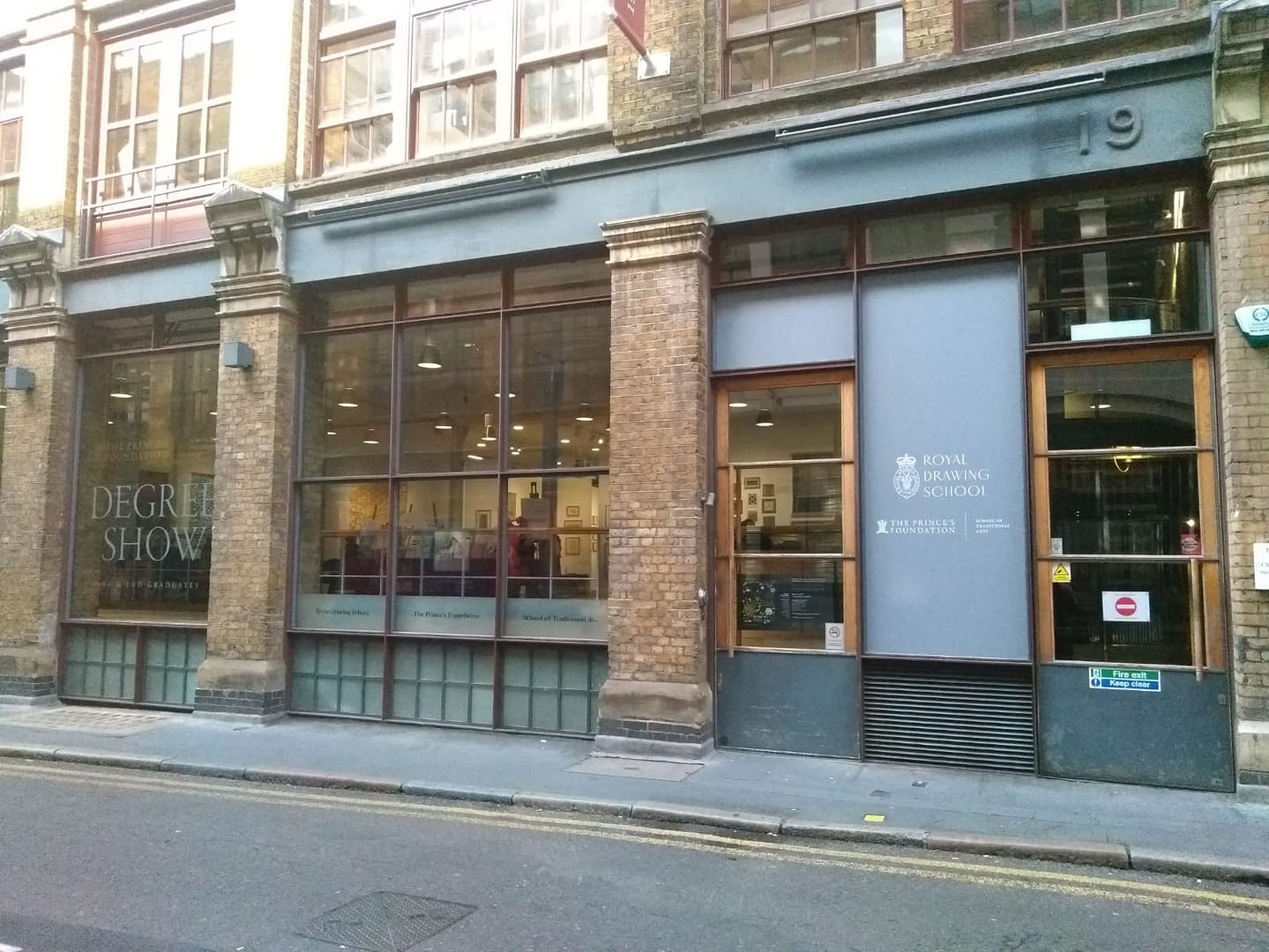
I went in and just sat around quietly along with everyone else in their very nice, neat lobby bit for a while (the disruptor in me just wanted to stand on the tables or throw paint around it haha!). At 10am, all 40 of us we were directed to go upstairs.
We were called up to the stop floor studio, this massive, beautiful wooden-floored space filled with easels and donkeys. We weren’t really given any instruction once we went in, but those who had never been there before followed the lead from the regulars who had done other short and evening courses at the RDS before. Pick a spot, get a board and sort your space out. Sounds obvious now, but there were plenty of bewildered people that morning!
We were soon told about the general outline for the week, and that there was a blanket ban of mobiles in the studio (to protect the privacy of the models). By the end of the week, most people tended to bend these rules slightly (myself included, though most of the time I stepped outside to use my phone), getting them out in breaks when the models weren’t present. Which is fair enough.
This first day was Life Drawing, pure and simple. There were two models, a man and a woman, and over the course of the day they got into various poses, individually and with one another, and using only charcoal and ink, we drew with what appeared to be a focus on form and negative space. The poses weren’t really very long for the most part, ranging from a few minutes to around 20 minutes in the morning, with three 45minute poses in the afternoon. The tutors came around to see everyone as they were drawing in silence (as someone who always works with music, focusing without it was challenging!), and were very encouraging with their pointers. I was dead chuffed to be called ‘bright’ and that my drawing was ‘beautiful’ by experts in the field. Confidence boost much! It was nice to just draw as I hadn’t drawn properly in a while, but it became clear to me very quickly that the modus operandi was very much all about traditional drawing – much more so than I anticipated. I draw very experimentally and although I was applauded over the fortnight for trying different styles and mediums, I could see that there wouldn’t be any room for concept-based approaches in an attempt to push line further. However, doing an intense period of pure observational work is how you get better, so it was still very welcome! I enjoyed the idea of focusing solely on technical skill development where you get to drawing interesting people, as even though I have a fine art degree, I’ve never had any real tuition in life drawing. Go figure.
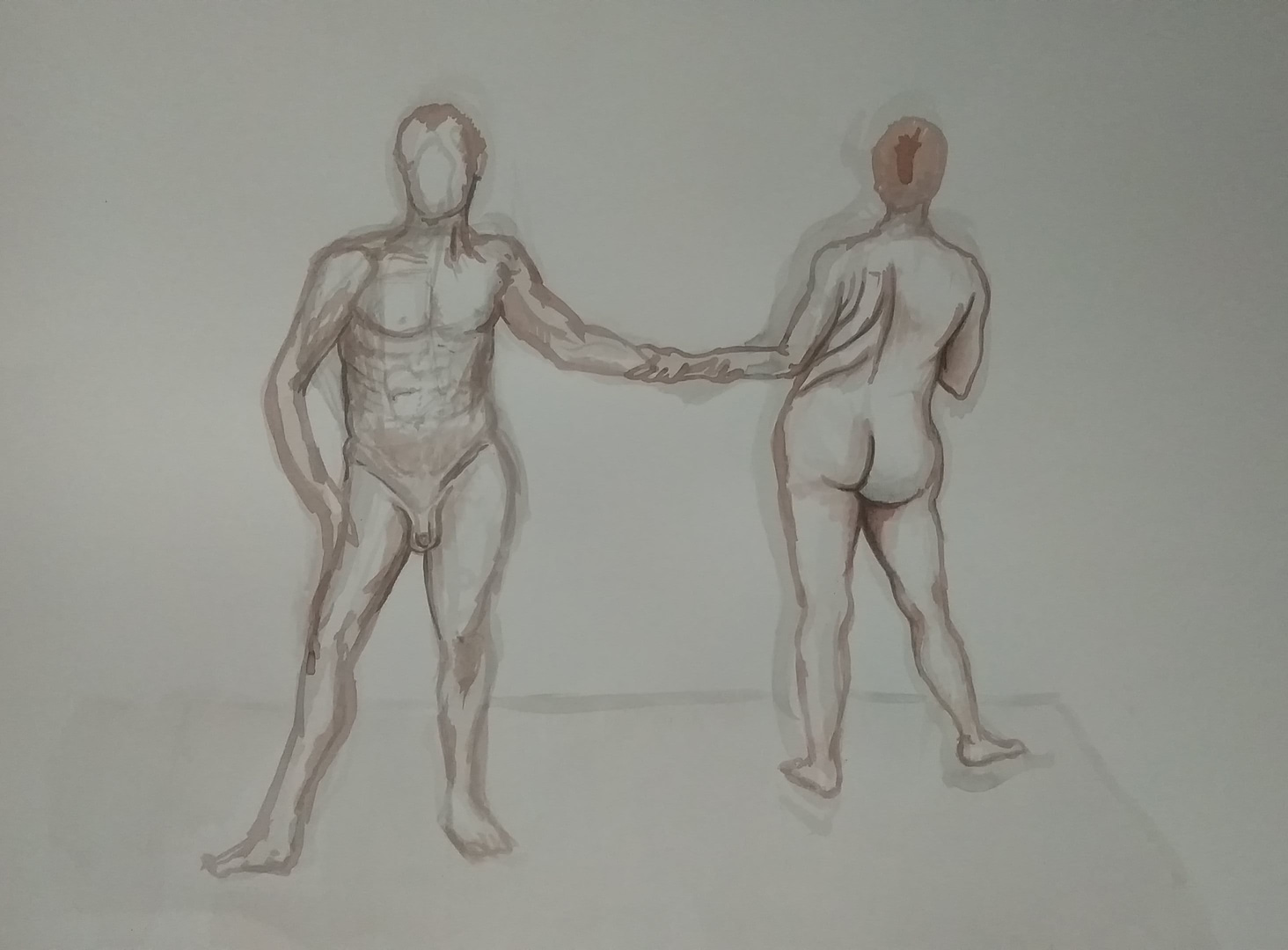
At the end of the day, went back to my Dads and hung out with my awesome little sister. It was a good first day and, despite some concerns, my nerves had settled considerably.
Tuesday 9th July
Following the morning commute in the boiling weather, I went back upstairs to the studio. However, now there was a partition through the middle, diving the massive space into two separate, smaller studios. Today was all about portraiture. I have literally only ever done ONE portrait in my life where it actually looks like the person – but because it was of a psychiatric service user in an in-patient ward… well, it’s not like I can ever really show it without breaching confidentiality, is it? Again, there were two models (clothed this time), a man and a woman, which we took turns in drawing. We did 10-20 minute pencil/ink drawings of them in the morning, before doing a three hour long drawing of them in the afternoon. Which, may I add, was TOO much. Tuesday was generally a really frustrating day for me. The only drawing I liked was a 20 minute one of the fella, which was a single-line contour drawing because I felt I had been too ‘controlled’ with my line before that:
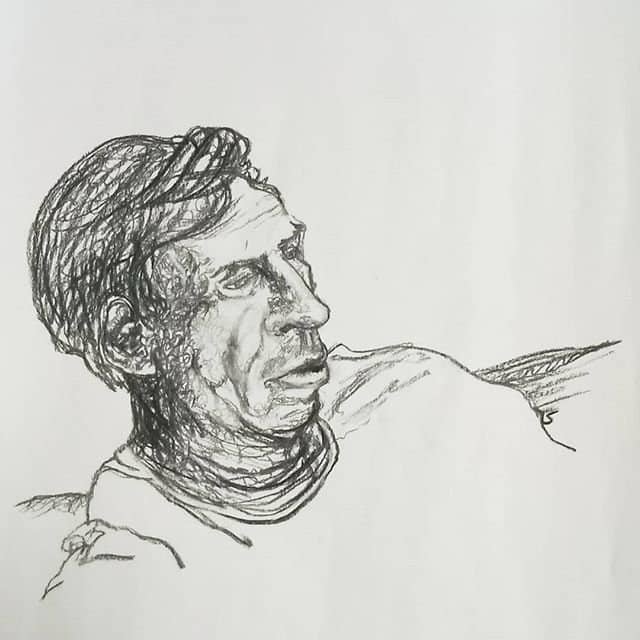
The tutor was lovely though; we got chatting and she’s now planning to come and visit Hull, and I said I’d show her around the city when she does.
That evening, my sister had invited her two best mates and her boyfriend over to meet me, and she cooked us all chicken/Quorn fajitas (which she did very well with) and watched Netflix together.
Wednesday 10th July
On Wednesday morning, I was already shattered on waking, and the heat and the daily commute was already getting to me, but I was really looking forward to this day.
This session was all about drawing a contortionist! Today was much more what I was used to – there was much more freedom and more experimental that what we had done before – since the model could only really hold her poses for relatively short periods of time. It was more about mark-making and expression, as opposed to precision and replicating life. As a result, I made at least 50 drawings, and some of these really quick sketches are some of my absolute favourite drawings from my time at the RDS.
We also had an hour lecture before lunch. It was about contorted bodies in art and it was very interesting. There were lots of examples of twisted, contorted figures, circus performers and dancers by various artists that she showed us. It surprised me that there was no real exploration of any cultural-social-political-historical-etc context in there though – like I’ve come to expect from arts lectures. Yet I put that down to time and the idea that it was probably made more simple to make it more inclusive of all students (this course was the first arty thing a number of students have ever really done). It was interesting though.
Today was a really good day for me. It was soured slightly by someone being snooty and responding really rudely to me when I explained that I’m interested in contemporary, boundary-pushing drawing. Like, they weren’t holding back on expressing literal distain, to my face none-the-less. If I were in a more mentally-robust place and it wasn’t at the start of my experience there, I’d have probably called out their rudeness and challenged them about it. It was obvious from first arriving that the RDS clearly favours artistic and aesthetic technical skill over nurturing any expressive/challenging creativity, but I never expected behaviour like that.
Thursday 11 July
This was another day I was really looking forward to. The Printmaking workshop was really limited in places so I was really fortunate to have a place on it. The whole morning was pretty much the induction to the workshop space though. Almost a 3 hour induction in a 6 hour day. For the last bit of the morning, we prepared aluminium plates to then etch into in the afternoon. We were not informed to bring anything with us but there was a bit of snarkiness about not having pre-prepared drawings with us to trace from (how I was going to directly copy an A1 drawing onto an A6 plate was beyond me). I traced a photo of a drawing from earlier in the week from my phone screen because I weren’t sure what else to do. Turns out I made a poor choice because it was hard to work into what was essentially a contour drawing. Because of this, I ended the day feeling quite disappointed and frustrated. I think if I was told to prep an appropriate image beforehand, it would’ve made the experience better. I wish I had drawn my cat in hindsight! Because there’s never enough artwork of cats in the world…
I enjoyed working with the chemicals and getting messy, but etching is a very long process that requires a lot of patience. I did a total of three prints that afternoon, in as many hours. I’ve done drypoint in the past and I really, really love the rawness and expression with line that is captured, where etching feels more about technical precision and a building up of tone. It was good to learn though. I’m like a sponge for knowledge, I love learning new things. If I had more time to experiment with the chemicals and processes, I feel like I’d have found my flow and found out how to make it work for me; I’d like to have another bosh at etching at some point though.
However. I felt really uncomfortable with how toxic printmaking is though, oh my god. I was reading the safety notices and considering the environmental implications of these chemicals/processes and as much as I was enjoying this new experience, I felt incredibly guilty. This stuff is awful. Like, awful. Why? With all our modern understanding, why haven’t the processes evolved? And for somewhere called the ROYAL Drawing School, you’d think they’d consider the eco-conscious messages their patrons have been promoting? Since the RDS, I met with fellow Emergence Bursary recipient Fae Kilburn, who is a printmaker and a lovely person. She used her bursary to go to Canada and has learnt all about environmentally-friendly printmaking processes (yes, nice one, Fae), so the ability and knowledge to make the necessary change is there. Why aren’t there more people who take the initiative to act more responsibly with their practice? It’s a strong opinion, but if you can’t find a way to make your practice less damaging to the planet, you’re either lazy, ignorant or not creative enough. Or maybe all three. Times are a-changing and we all have a responsibility to step up. I’m digressing into a whole other thing now but you get my point!
On Thursday evening, I met up with my little sister at the Wellcome Collection in Euston, to go see this exhibition on called Smoke and Mirrors: The Psychology of Magic. It was really good! There were collections of magic memorabilia, from Victorian mediumship equipment, to giant poster prints, to Tommy Cooper’s Fez to Dynamos magic set for kids. There were videos explaining how tricks expose habits/presumptions of the mind to ‘create magic’. What’s more, there was a great magician (with a PhD in magic) giving a lecture on the Golden Age of Magic whilst performing tricks. It was seriously cool and both of us really enjoyed exploring the exhibit. My sister then wanted to go to McDs for dinner, which we did, before heading home.
Friday 12 July
Friday was another whole day of life drawing. I was curious to see if I could see any improvement from my drawings on Monday compared to today. We had good strong models (male and female, as before) and one of the tutors was very philosophical. I think he lost a lot of students with the speech he gave. I’m lying if I said I remembered what it was about but I felt I grasped the concept… about experience and living through drawing. I think. Did lots of various poses today, mostly between 2 – 20 minutes and I mostly used charcoal again.
There was nothing hugely specific from the day today, except for most of the afternoon was a ‘crit’, exploring our favourite pieces from the past week. Again, no one had told us this was going to be the case, as most of us worked on large separate sheets of paper and, considering that we couldn’t leave anything there overnight, most people only had drawings from that day to choose from. I didn’t like most of my work from that day, so I felt annoyed that I was unprepared to show for a crit (I heard lots of murmurs of frustration from my peers about this too), which are far and few between once you leave uni.
Everyone laid out their work (5 pieces I think of ones you liked, and didn’t like) all over the floor, and the mass crit began. There were 40 people to go around, and I’m not going to lie, it seemed to take forever and it hot, uncomfortable and almost everyone got bored and tired of it really quickly. Luckily, I was one of the first five to have their work looked at. I was hoping for some real critical feedback and pointers about what I could focus on improving, but it to be honest, the crit was lacking. The comments were pretty complementary but they felt empty and kinda fluffy to me; I recognise that they’re not going to be critically honest to people who want to learn, especially if they’ve never had a crit before… but how am I supposed to know where I’m technically lacking without encouragement to work x, y or z? I listened to other peoples crits in the hope of picking up a few tips, but they felt equally as fluffy. It also surprised me to not be given evaluation/feedback forms at the end of the week.
I then headed on over to the Royal Academy to see the Making of an Artist: Learning to Draw exhibit (with the intention of popping into the Summer Show after). The exhibit wasn’t as big as I thought it would be – it was literally a corridor – but it was full of sculptures that ye olde academicians used to learn to draw from before they progressed onto drawing living flesh. There were big ole’ statues of muscley men and svelte women, but the most interesting ones were statues of people with the skin and flesh removed at various depths.
Apparently, these statues were of dead bodies that had been forced into poses, had their skin removed and then cast in plaster. I sat and drew one for an hour and a half, and dya know what? I learnt so much about human anatomy. I loved it. I could’ve sat and drawn longer but I was hungry and it was nearly kicking out time, so I headed back home to my Dads.
And that was my first week! Now I’ve had some time to digest and reflect on such an intense week, there’s a few (honest) thoughts there that have stood out for me.
General observations from the first week:
- I felt like I peaked around lunch time every day. Either that’s the time when I work best, or I need a few hours to warm up to get to my optimum level before I get tired. This may be useful information!
- I really enjoyed having the space to just observe and draw. Time is very limited and noone tells you that at least two thirds of being an artist is admin, so to just draw was lovely and very regenerative.
- I appreciated just being given things to draw because I didn’t really have to think (which as an anxious overthinker and someone who falls into concept-heav work) and it was refreshing!
- I work better and am more comfortable on donkeys than easels.
- Bearing in mind that there’s a (rather heavy) suggested materials list, I barely used any of it as most of the time we were encouraged to just use charcoal and ink, which was there to use already! I can imagine that for people with physical disabilities, this would pose quite a problem.
- On that note, the course generally didn’t feel accessible to some people with disabilities. Yeah there was a ramp into the lobby and a lift, but beyond that it felt like there was little consideration. And for the first week the lift didn’t work properly at the top studio floor. The room was way too hot (no temperature controls in a stuffy London loft with limited windows when its 38C outside) and 40+ strangers in a room felt pretty overwhelming at times. It was too quiet (which for some is a good thing) but a blanket ban of mobiles in the studio meant that when I was anxious and struggling, I couldn’t listen to my music via earphones; if I knew of the ban beforehand, I could’ve prepared better and dug out an mp3. There was a tendency to use fancy language and there was no offer to read information beforehand. I think that when applying to the course there’s an access requirement box, but you don’t anticipate a phone ban or that 38C is an acceptable temperature to work in.
- I felt that the Drawing Marathon experience lacked communication and at times didn’t feel as tightly organised as you’d expect from somewhere with ‘Royal’ in it’s title. There was very little information given online (am I going to be doing traditional drawings? Experimental drawings? Lots of life drawing, drawing from life, drawing from imagination, or a combination? Who is my tutor?) and again, little information prior to the course (how much paper do I bring? I may need to budget, how much is the paper there? Do we need to bring all our materials every day? Or not? To which ones?). During the course, it would’ve been good to have been given more of a heads up about things (like simply to be told what to do when you first got to the studio on the first day, or to prep drawings for the print workshop, or to bring in work for the crit). Sometimes, when there was more than one tutor, it didn’t feel like they were necessarily on the same page.
- I am fairly well read on wealth inequality, and find great issue with economic inequity. Although I fully admit I may have a slight chip on my shoulder about it, there is a definite class thing going on there. It was one of my biggest concerns before going because of really bad class-based prejudices, discrimination and bullying I have experienced in the past at another prestigious art establishment. I felt it before even going and was confirmed to me the second I walked into the building – which is weird really, considering the RDS is all about making drawing tuition accessible, open and affordable to anyone and everyone. Although there were a mix of people from various backgrounds, many of the students (and others occupying the building) very clearly and obviously came from money. There is no financial concessions available for their summer courses (why?)… but considering that it is the only opportunity that folks outside of London may have to get a feel for the place before applying for a Drawing Year Scholarship (especially important if you’re a disabled artist, I’d argue), it isn’t exactly accessible. Only reason I was able to do it is because the £550 course was paid for using my Emergence Bursary (thanks again a-n, Shape Arts and DAO!). If I wasn’t able to stay at my dads house in London, the bursary wouldn’t have been able to also cover two weeks in a hostel/hotel, travel and access needs, so it goes to show how expensive the experience was. I don’t know the point I’m trying to make here. Maybe it’s wrong to draw conclusions after only being there for a short space on time, but I think that although the school is inclusive and accessible in princple, it possibly isn’t in practice.
I’m pointing out lots of negatives here, aren’t I? That’s not intentional! But the reason I rewrote this blog is because in the first draft I omitted a lot of the critiques. Yet I rewrote it all and included these things because they’re big issues that need talking about aren’t they?
I enjoyed my first week there and really valued the opportunity afforded to me. I churned out many drawings (both good and bad!) and I feel like I had got better at drawing. How or what exactly, I can’t pinpoint though! I spoke to some lovely people, and my tutors were ace. I was looking forward to my second week, which I’ll tell you all about in a second post soon!
